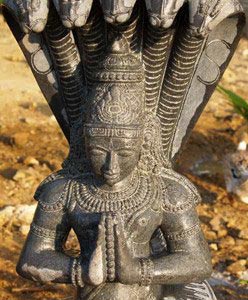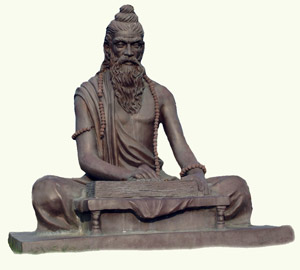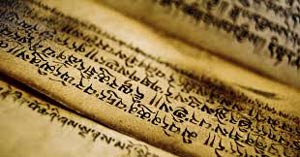Editor's Note: Dr. Miller has translated several classical Indian texts from Sanskrit into English. In the last issue we published a seminal text of Advaita Vedanta - Drg-Drsya-Viveka: An Inquiry into the Nature of the Seer and the Seen. We now bring you Richard's translation of Patanjali's Yoga Sutras as a four part series along with his rich insights and incisive commentary.
Click here to read Part Two in the January edition
The Yoga Sutras are comprised of 196 terse aphorisms, which are attributed to the sage Patanjali (Sanskrit: Grace-filled), who recorded
them around 450 BCE. While Patanjali’s true identity is lost to antiquity, myths abound as to who he really was. Patanjali is reputed to have been an
incarnation of the serpent God, Ananta (Sanskrit: Infinite) and is depicted in statuary as possessing a body that is half human and half serpent.
Statues often portray him as sitting absorbed in meditation, with hands folded in Anjali Mudra, bestowing his blessing upon all who approach him seeking
enlightenment through the teachings of Yoga.
Patanjali is cloaked above by a cobra’s hood comprised of five serpent heads, which represent his freedom from misperception and ignorance, and symbolize
his mastery over the five elements of earth, water, fire, air and space, and his enlightenment through the practices of Yoga. Below the waist Patanjali’s
body is comprised of three and a half snake coils, representing his all-powerful nature as Ananta. These three and a half coils represent his mastery of
the three worlds and three powers including:
- earth and omnipresence (first coil),
- atmosphere and omnipotence (second coil),
- heaven and omniscience (third coil), and
- freedom from the material world (half-coil).
In addition to his two hands held in the blessing attitude of Anjali Mudra, Patanjali possesses additional hands holding:
- conch, which calls students to the practice of Yoga,
- discus, which represents the law of cause and effect through the turning of the wheel of time, karma and dharma, and
- sword, which represents discriminative wisdom that cuts through all misperception, doubt and ignorance).
Patanjali is reputed to have been a master of many achievements including:
- a patron of dance to whom many to this day continue to invoke his blessings before performing their craft,
- an authority on Ayurveda who addressed issues such as diagnosis, form, function, fitness, and the administrative of medicine,
- a grammarian who wrote the Mahabhashya, an authoritative commentary on Panini’s Sanskrit grammar, and
- the author of the Yoga Sutras.
Confusion as to the deeds that Patanjali actually performed abound. One controversy concerns the fourth pada, or chapter of the Yoga Sutras, as its style, content and length are different from the first three chapters. While the first three chapters present their content in
a leisurely and non-dogmatic manner, the fourth chapter, by contrast, conveys its message in a more insistent manner. Also, one sutra in particular, IV 16,
appears to have been lifted from Vyasa’s commentary on Yoga, and in traditional renditions, both the third and fourth chapters’ end with the word ‘iti’ (Sanskrit ‘thus it is said’), which is a traditional way of ending a Sanskrit text, thus suggesting that there are two ‘The End’ to
this one book, thus lending confusion as to whether the fourth pada was an addition by a later author. That said, all four padas taken together deliver an
interwoven tapestry of outstanding homogeneity and consistency.
Yoga existed before the time of Patanjali, who appears to have been of the Shramana tradition (wandering forest yogis) and was a synthesizer of the various
streams of Yoga that existed during his lifetime. Many Upanishads, recorded as early as 1100 BCE, make unequivocal references to pranayama,
asana, and yogic disciplines. And by the time of the Mahabharata (written around 400 BCE and conveying events that took place much earlier in the
8th and 9th centuries BCE), both Samkhya and Yoga are well-established systems of spiritual inquiry. Patanjali, then, appears to have
come much later, compiling in his Yoga Sutra trends that were found in the much earlier streams compiled by Kapila (Samkhya) and Hiranyagarbha
(Sanskrit: Golden Womb) from which all Yoga teachings are thought to be derived.

While Patanjali’s actual identity is lost to antiquity, his Yoga Sutras is an extraordinary text that expounds upon the nature of human
psychology, spiritual self-inquiry and practice, and the realization of freedom and embodiment of our highest potential as human beings. It is a source of
inspiration that conveys core themes upon which all spiritual traditions, East and West, have built their houses. [1]
The Yoga Sutras of
Patanjali describes the path, means, description, and realization of our most essential nature. Based in the dualistic philosophy of Samkhya, each of
Patanjali’s 196 sutras presents us with a means for realizing our essential nature by way of our differentiating what changes (prakriti
-nature) from what doesn’t change (purusha-essence). Patanjali presents us with a dualistic perspective, based on its underpinnings of
Samkhya, that results in our freedom from the various changing movements of body, senses, mind and world, and the realization of our essential
non-changing nature. Even though some schools of nondualism dismiss the teachings of Patanjali as a lesser dualistic perspective, when viewed within
the comprehensive teachings of yoga that include Advaita and Kashmiri Nondualism, Patanjali actually forms the first foundational stone in spiritual
understanding that ultimately culminates in our awakening into the fullness of the nondual realization that embraces everything as an expression of
essential nature. From this perspective, Patanjali offers us a first ‘way station’ in our travels towards our full and comprehensive awakening, a first
blossoming in our flowering into freedom.
When reading Patanjali, keep in mind that each sutra is a condensed and pithy statement that contains multiple meanings, as each Sanskrit word can be
defined in a variety of ways. For instance, the word nirodhah, which appears in the second sutra and defines the nature of yoga, can be translated
as either a verb (‘to still’) or a noun (‘stillness’), or both. Knowing this enables us to fully comprehend the depth of understanding that Patanjali
offers us. It’s also important to contemplate each word within both the context of the sutra where it appears, as well as the sutras that come before and
after. Each word can be likened to pearl on a strand (sutra). Only by understanding the entire strand, or text, are we truly able to understand a
particular word or sutra that appears in Patanjali’s presentation.
Patanjali’s treatise is comprised of 196 pithy statements or sutras, which are offered in groupings of one or more sutras. Each grouping defines a
particular topic, or piece of the puzzle of awakening. For example, the first four sutras of chapter one define what yoga is. Reading each sutra without
understanding the particular grouping within which it appears can lead to confusion. Therefore, it’s important to first understand the topic that a
particular grouping of sutras is addressing before diving into the individual sutras that comprise the grouping.
In my interpretive translation of Patanjali, The Flowering of Freedom, I offer you the four chapters of Patanjali’s Yoga Sutras, as well
as the groupings that appear within each chapter, and questions that students may have been asking of Patanjali back in 450 BC, which led him to unfold
this timeless treatise on the nature of reality, the ending of suffering, our liberation and freedom from misperception, and the realization of our
essential nature.
Chapter I
Samâdhipâdah
atha - now samâdhi - absorption pâdah - chapter
Now begins the chapter on Absorption
I. 1-4. Yoga is Defined
What is Yoga?
I.1 atha - yoganushasanam
Now
that you are a sincere seeker of truth, free of preconceived notions and possessing the right disposition of sincerity, faith, and heartfelt
interest, you are ready to hear, receive and contemplate the essential teachings with regards to attaining trueliberation and freedom from the misperceptions that otherwise distract your attention from truly understanding your essential nature.Now begins the communication, description and instruction regarding the right path, means, and realization for liberation and freedom with regards to the distinction between what it is that is ever-changing (prakriti) and essential nature that is
ever-new, fresh and vital, yet is never-changing (purusha).
atha
: now; realization of this moment; transition from one state to another
a
: sound of creation; this moment as ever changing (prakriti) yet always the same (purusha)
tha
: bestow; compassion; wholeness
yoga
: clearing misperceptions that otherwise obstructs right understanding of essential nature; the path, means and realization of essential
Nature
anushasanam
: teachings; means of understanding
anu
: the now experiencing itself over and over again
nu
: rebirth
nam
: in reverence
sham
: stillness; ever-tranquil
shas
: right means of understanding
shishya
: one who is open and ready to learn
 In your mind’s eye, imagine yourself sitting with the sage Patanjali under a tree in ancient India, pondering his first question to you: “Atha?”,
which is the question Patanjali open his treatise on the Yoga Sutras with. ‘Atha’ literally means ‘now’. This word opens us into a world
that is rich in meaning, for ‘atha’ entails ‘time’. With this first word Patanjali is asking, “Do you understand the nature of time and what time truly entails? Do you understand the nature of reality?” With this first inquiry, he’s asking
us, “Do you understand your essential nature, which is beyond time.”
In your mind’s eye, imagine yourself sitting with the sage Patanjali under a tree in ancient India, pondering his first question to you: “Atha?”,
which is the question Patanjali open his treatise on the Yoga Sutras with. ‘Atha’ literally means ‘now’. This word opens us into a world
that is rich in meaning, for ‘atha’ entails ‘time’. With this first word Patanjali is asking, “Do you understand the nature of time and what time truly entails? Do you understand the nature of reality?” With this first inquiry, he’s asking
us, “Do you understand your essential nature, which is beyond time.”
Because, as a seeker, you wouldn’t have possessed the awakened understanding, Patanjali’s response to your “No, I don’t understand, please do instruct me.”, would have been, “Anushasanam!” With this word Patanjali is saying to you,
“Ok! Then let me explain the teachings of yoga, which will enable you attain your freedom from misperception and suffering, and awaken into the right
understanding of your essential nature.”
In other words, “Now, let the teachings of yoga begin!”
What is Yoga, and when does yoga happen?
I. 2. yoga - cittavrittinirodhah
Yoga is
when we realize and abide as our essential nature—stillness—that is without movement, whether the mind, as the movement of thought, is in movement or is not in movement.
yoga
: clearing the misperceptions to misperception; realization of our non-changing essential nature; the path, means, and realization of essential nature
citta
: material of the mind
vritti
: movements or activities of the mind
nirodhah
: stilling (v); stillness (n)
The word ‘yoga’ implies many possibilities. This first chapter on the nature of absorption (samadhi) clarifies how yoga is to be
understood in this particular treatise by Patanjali. Yoga, for Patanjali is our ability to remain absorbed without distraction, wherein the mind has ceased
identifying with the waves of thought, so that the underlying stillness of our essential nature is recognized. From this perspective yoga arises when we
realize the truth of our natural state of timeless stillness, being and awareness. Yoga is therefore ultimately beyond samadhi as a state. Yoga ultimately
entails awakening into our ‘open eyed’ (sahaja) or nature non-state of being-awareness, which is uncaused, steady, always present and unbroken.
Our mind has three tendencies, to: 1) externalize attention, 2) objectify whatever is arising in awareness, including awareness, and 3) constantly jump
from one object to the next. These tendencies keep the mind in constant movement to such a degree that the background within which the mind is
arising—stillness—goes unperceived against the whirling foreground of activity. At a certain point in life we will each experience an inner emptiness due
to our felt loss of connection to what lies deeper to the superficial meanderings of our mind. Here, a spontaneous movement of thought begins within us,
which questions this tendency of our mind. Natural questions arise as to: “Who am I?” “What am I?” “Who is another?” “What is another?” “What is the purpose of life?”
Patanjali understands the dilemma we face at this point, as well as the two types of seekers that sit before him. He gives both direct (for those who are
ready) and indirect answers (for those who need more time to ripen) to the question as to what brings true freedom and happiness. The direct answer he
gives in this sutra is that our true state is unbroken and uncaused. All that needs to occur is to see life as it is, without anticipation or expectation,
and to recognize the underlying stillness that is, and has always been, present. In this open-eyed seeing discriminative wisdom arises as to the nature of,
and difference between, the seer and the seen. Patanjali also provides an indirect answer for those who do not directly perceive this simple truth. For
these seekers he recommends an eight-fold path (ashtanga yoga), which purifies the mind, dissolves misperception, and gives rise to discriminative
wisdom, so that direct understanding may be perceived. Many names have been given to this realization of yoga: non-conceptual understanding, consciousness,
infinite, God, awareness, being, mystery, or essential nature.
While I like the word ‘mystery’, as it gives the mind nothing to hold onto, for the sake of my writings, and in keeping with Patanjali, who uses the
term purusha, I’ll refer to ‘this’ that is beyond name and form as ‘essential nature’.
This essential nature that we truly are is not the result of any action. It is what we already and always are being. Essential nature is recognized when
the fluctuating waves of the mind are recognized to be arising within the underlying essential nature, or stillness, that is the ever-present background of
all movement and non-movement. Yoga happens when identification with the fluctuating waves of our mind ceases, and the radical understanding dawns that we
are ineffable stillness, which is always present, which is independent of thoughts being present or absent.
What happens when the realization of our essential nature arises?
I. 3. tada - drashtuh - svarupe – avasthanam
Then
, when Yoga is, essential nature rests knowingly in and as itself. There is no longer confusion or identification with the movements that arise
within the mind. Essential nature is realized as always present, whether the mind is in movement or is still.
tada
: then; when Yoga happens
drashtuh
: seer; essential nature
avasthanam
: resting; abiding
svarupe
: own true form; essential nature
sva
: own; true
rupe
: form
When yoga happens, essential nature is recognized as always present. There is no longer transference of self-identity to the mind, body, senses, etc. The
movements of the mind (vrittis) have ceased to be identified with.

What happens when one does not reside knowingly as essential nature?
I. 4. vrittisarupyam - itaratra
At other times, when yoga is not
, the mind is busily occupied with its own movements. Because of this there arises confusion, misperception, and identification by the mind with its
own movements, which gives rise to distorted understanding. A movement of thought is mistakenly identified as a seer and the real
seer, essential nature, remains hidden behind a veil of misperception and mistaken identity.
vritti
: tendency; activity of the mind
sarupyam
: similarity (sa) of form (rupe); mistaken identification
itaratra
: at other times
At other times, when yoga is not realized, the true nature takes on the appearance of the thoughts, or waves, of the mind. The view of Samkhya–Patanjali
unfolds in a number of realizations.
-
Essential nature (purusha) is understood to be separate from the movements of the mind and nature (prakriti).
-
A modification of nature (prakriti), the mind (manas), gives rise to the ego-I thought (ahamkara), which gives rise to the sense of ‘me’ or ‘mine’ (asmita), which is falsely perceived by the mind as the seer. The true seer is essential nature (purusha).
-
Mind gives rise to the senses.
-
Senses give rise to their objects, whereby name and form appear.
-
The mind, identified with the senses, their objects, and the ego-I thought remains unaware of essential nature.
-
Through yoga, objects are recognized as movements arising to the true seer, essential nature.
-
The recognition of the changing nature of objects gives rise to discriminative wisdom (viveka-khyati) of the difference between these
changing objects and the true unchanging seer.
-
Through unbroken attention, discriminative wisdom arises that this seer, as ego-I is, just another object.
-
Then the seer, itself, becomes an object of attention.
-
Through unbroken attention wisdom arises as to the nature of the true seer (purusha), and the true seer abides in and as its own nature,
separate from the ego-I seer (ahamkara-asmita) of nature (prakriti).
-
Freedom (kaivalya) of the difference between the true seer, essential nature (purusha), and the false seer (prakriti)
arises.
-
The recognition is present that essential nature (purusha) always is, separate from nature (prakriti), which also always is.
To be continued…